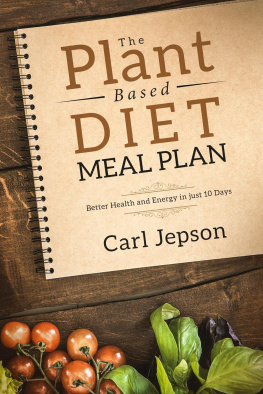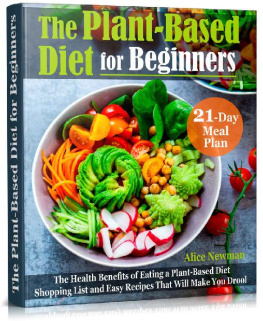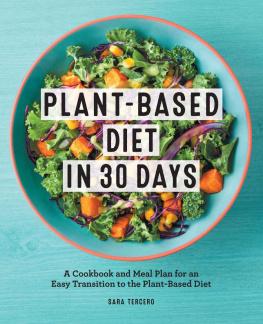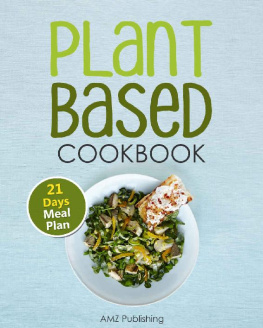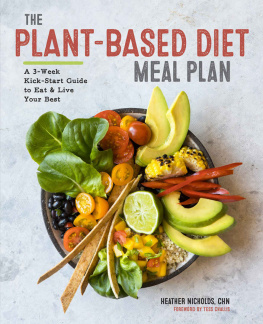The Beginner's Guide to
a Plant-based Diet
Use the Newest 3 Weeks Plant-Based Diet Meal Plan to Reset & Energize Your Body. Easy, Healthy and Whole Foods Recipes to Kick-Start a Healthy Eating.

Brandon Hearn 2018
Table of Contents
Introduction
A plant-based diet is all about celebrating and enjoying the foods that naturally fuel our bodies and are minimally processed. By improving your nutrition, you can improve your health, which is exactly what the plant-based diet is about. Dont dramatically change your diet without consulting your doctor to make sure that there will be no medical issues, such as problems with medications you may currently be on. You should also gradually change to the plant-based diet if you are a heavy meat eater.
Its that simple and I like to keep things that way. Yet not every plant-based diet is the same. You can make i t your lifestyle and adjust it as you see fit.
You should feel energized because of the foods you eat, never lethargic or drained. Our bodies are incredible machines and the foods we eat are what help maintain and protect our awesomeness. That is what the plant-based lifestyle is all about.
Thats all there is to it, but lets break it down a little further.

What Youll Be Eating
Youll be eating the following.
- Starchy Vegetables: This includes all kinds of potatoes, including sweet potatoes, legumes, which is all kinds of lentils and beans, whole corn, root vegetables and quinoa.
- Non-Starchy Vegetables: This includes your leafy greens, broccoli, eggplant, tomatoes and more.
- Whole Grains: This includes things such as brown rice, oats, whole wheat and more.
- Fruits: All fruits are included if theyre found in nature. This doesnt include juice or dried fruits.
- Spices: You can use all spices
- Beverages: Your beverages are limited on this diet. You can drink unsweetened plant milks, decaffeinated coffee, decaffeinated tea and water.
- Omega 3 Sources: Your omega 3 sources are flax seed and chia seeds.

Eat These Sparingly
These are foods that you can have once in a while, but you should eat them sparingly.
- Nuts: The nuts you can eat sparingly are almonds, cashews, walnuts and peanuts.
- Seeds: The seeds you can eat sparingly are sesame, pumpkin and sunflower.
- Dried Fruit
- Coconut
- Avocado
- Added Sweetener: Use maple syrup, fruit juice concentrate and natural sugars sparingly
- Beverages: You can have caffeinated tea and coffee occasionally as well as the occasional alcoholic drink.
- Refined Protein: You can have refined soy and wheat protein sparingly
- Tofu, Wheat Gluten Protein & Soy Protein Isolate

The Basics
There is no portion control, no carb counting and no calorie counting with this diet plan. You can eat when youre hungry, and you can eat until you get full. Simply make sure that you choose food from the right categories. Of course, there are going to be exceptions that youll need to make occasionally. You need to be sure that you arent eating too often from your sparingly food category for example.
Choose the One for You
You can choose the plant-based diet for you! Here are some of the most common plant-based diets out there.
- Veganism: This is a diet that includes legumes, fruits, grains, vegetables, nuts and seeds, but youll not be able to eat any food thats sourced from animals.
- Raw Veganism: This is a diet that includes uncooked and some dehydrated foods.
- Vegetarianism: This is a diet that consists of legumes, vegetables, nuts and fruit. You can include eggs and dairy in this diet, but you arent allowed meat.
- Fruitarianism: This is a vegan diet that primarily involves fruit, but you should not use this if you are diabetic.
- Ovo-lacto Vegetarianism: This encourages that you eat eggs and dairy along with your fruit and vegetables.
- Ovo Vegetarianism: This is where you are allowed to eat eggs with your fruits and vegetables, but you still cant have dairy.
- Lacto Vegetarianism: This allows you to have dairy but no eggs with your fruits and vegetables.
- Semi-Vegetarianism: This is a mostly vegetarian diet with the occasional time that you can have meat.
- Pescatarian: This is a semi-vegetarian diet that allows you to have dairy, eggs, shellfish and fish.
- Macrobiotic Diet: This diet highlights whole grains, beans, miso soup, sea vegetables, vegetables, and naturally processed foods. This can be done with or without seafood and other animal products.
Tips for This Diet

Here are some tips to get you started so you can stick to this diet with ease!
Look for Milk Alternatives
There are many non-dairy milk alternatives out there. There is coconut, cashew, Brazil nut, rice, almond and even hempseed milk substitutes out there. Most can be used in equal measurements, especially in baking. Just make sure youre using their unsweetened versions. The best is that most of these milks are rich in calcium so you wont be missing out.

Look for Egg Alternatives
You can also replace eggs in recipes. You can use six tablespoons of water with three tablespoons of chia seeds or ground flaxseeds. Just soak them for five to ten minutes so that the mixture becomes gelatinous. You can also use a quarter cup of pureed banana or a quarter cup of applesauce depending on the recipe. Each one of these is the equivalent of a single egg.

Look for Cheese Alternatives
There isnt a substitute for cheese, but the plant world does have soft and creamy textures that can take the place of cheese. It does make a small change in the taste of the dish, but it isnt too bad. The most popular replacements are soaked and blended cashews, sliced avocado, sprouted soft organic tofu, and nutritional yeast.
Look for Meat Alternatives
For a rich, heart texture that will help to fill you up there are beans, Portobello mushrooms, tempeh, and tofu. Each of these are chewy and hearty, and they can be marinated to get different flavors. You can also use these for chili, stews, and burgers or can be served baked.

Be Careful Eating Out
It can be hard to dine out when youre trying to enjoy a plant-based diet. However, there are many restaurants that offer vegan options, so try to look for one in advance. Just realize that youll need to minimize the number of times you eat out. However, if you need to go out then check out the menu online before you arrive. Look for dishes that are low in fat and full of vegetables, and then look for grilled, baked and steamed options. Try to avoid any dishes that are fried, rich, creamy or crispy. Just dont be shy about asking for a different salad dressing or side dish either. Make sure sauces and cheeses are left out too. If theres bread, ask for whole wheat. If there is rice, ask for brown rice.






